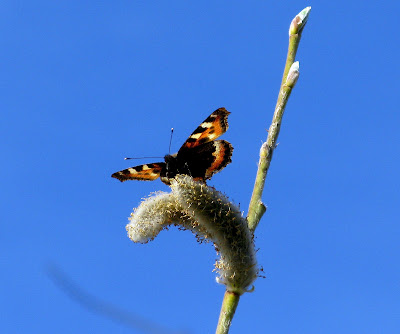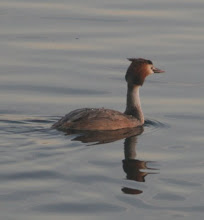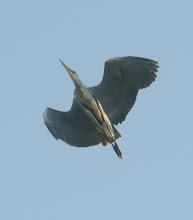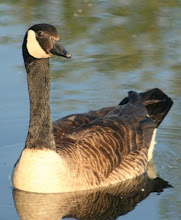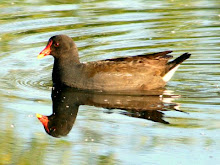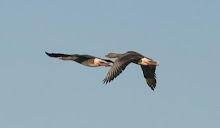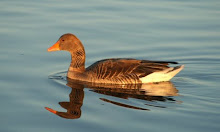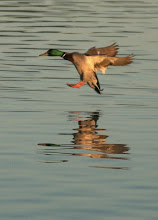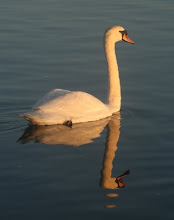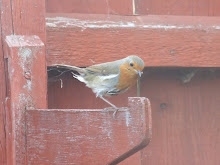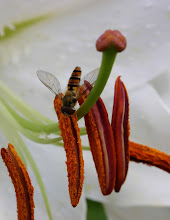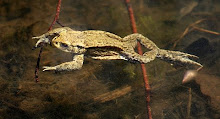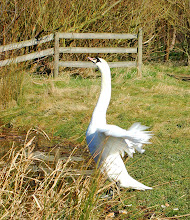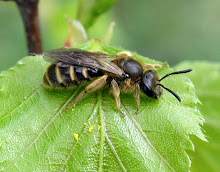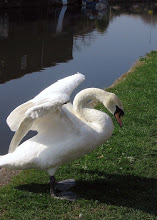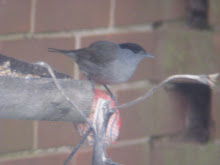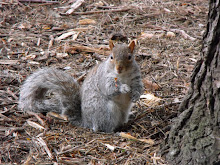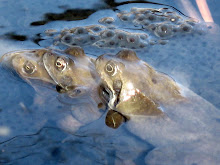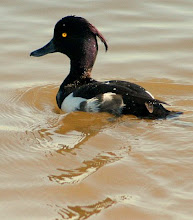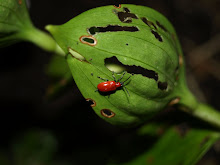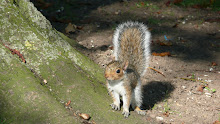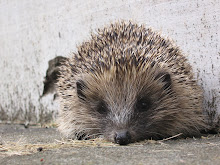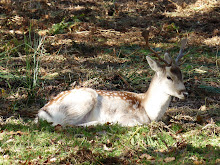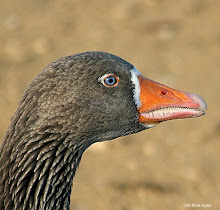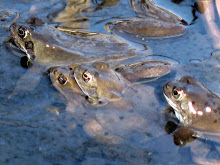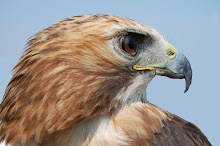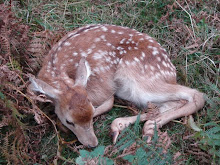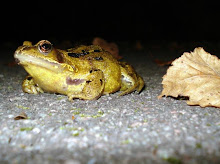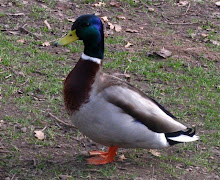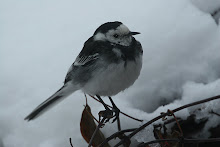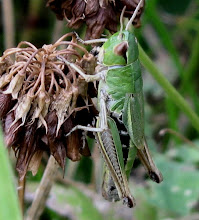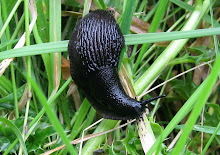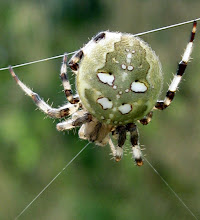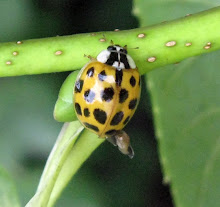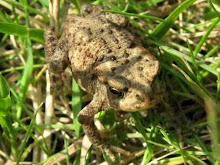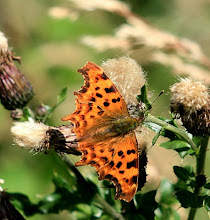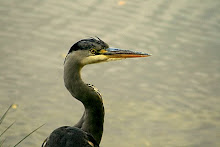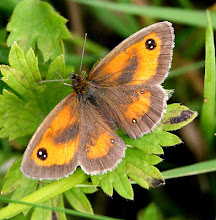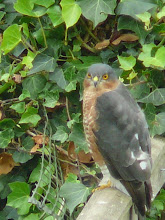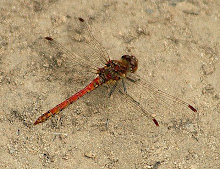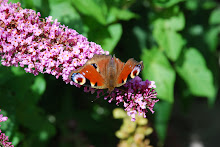IT'S A BUG'S LIFE
Even though their ickyness sends shivers through the spines of many a person, bugs are fascinating creatures...honest! Insects, spiders, and other creepy crawlies make up most of the animal life on earth.
Insects have been around for something like 350 million years. Many years before humans showed their faces. Humans appeared about 130,000 years ago.
With bugs being such a massive part of our world, you might as well learn more about them, and you never know, you might even grow to like them?
Alright, so you do not want to make friends with bugs. But you still might like to invite them to dinner – that is, if you are an adventurous eater! No being serious, there is a wealth of information at the click of a link here on NatureWatch. The BBC's Springwatch, and AutumnWatch sites are fantastic, as are the others, so get that mouse clicking and start learning.
You do not have to like insects to appreciate them. But now that you can see how interesting and beautiful they can be, you may not be so quick to squish the next bug you see. Instead, get that camera out and send us a photograph.
Send in your photographs of birds and butterflies too. In-fact, send in your pictures of all things to do with nature. Whatever it is, let us have it. We LOVE it!
Insects have been around for something like 350 million years. Many years before humans showed their faces. Humans appeared about 130,000 years ago.
With bugs being such a massive part of our world, you might as well learn more about them, and you never know, you might even grow to like them?
Alright, so you do not want to make friends with bugs. But you still might like to invite them to dinner – that is, if you are an adventurous eater! No being serious, there is a wealth of information at the click of a link here on NatureWatch. The BBC's Springwatch, and AutumnWatch sites are fantastic, as are the others, so get that mouse clicking and start learning.
You do not have to like insects to appreciate them. But now that you can see how interesting and beautiful they can be, you may not be so quick to squish the next bug you see. Instead, get that camera out and send us a photograph.
Send in your photographs of birds and butterflies too. In-fact, send in your pictures of all things to do with nature. Whatever it is, let us have it. We LOVE it!
Monday, August 03, 2009
This blog has come to an end....
YES, I'm afraid the Colin Stainton NatureWatch blog will receive no new posts, but the Loughborough Echo will continue to feature NatureWatch photos regularly, so if you have any photos you wish to appear in the paper, please email them to David_Godsall@mrn.co.uk
Tuesday, July 28, 2009
Beetle of the Month by Bill Phillips
August
Longhorn Beetles – Wasp Mimics
Longhorn beetles (Family Cerambycidae) are named because of their long antennae that are always at least two thirds as long as the body (sometimes four times as long!) The bodies of these beetles are long, narrow and with parallel sides, and development usually occurs in deciduous trees or conifers, where the grub-like larvae live under bark or bore into wood.
The strikingly marked Wasp Beetle, Clytus arietis, (Photo 1, Stonebow Washlands, late May 2009) mimics wasps in colour and shape, and also in behaviour.

It runs quickly with jerky movements and is wasp-like in flight. Found in or around woodlands throughout Britain from May to July, adults feed on the nectar and pollen of flowers which are often also visited by wasps. The beetle (20 mm in length) is harmless (without a sting) but gains a survival advantage from resembling a wasp, as birds avoid eating it, or at least hesitate long enough for the wasp beetle to escape! Females search out dead or decaying timber in the Spring, where they lay their eggs. The larvae take two years to develop fully because of the low nutritional value of dead wood. Predators of the beetle include birds which dig out the larvae
and pupae, and parasitic wasps which bore into the wood and lay their eggs inside the beetle larvae.
One of the commonest and most widespread of longhorn species is the Spotted Longhorn, Strangalia maculata, which also has wasp–like black and yellow markings, of highly variable patterns, on its characteristically tapered elytra (wing cases)

(Photo 2, Stonebow Washlands, July 2008). Adult beetles (14 – 20 mm in length) are found feeding on the pollen of flowers, especially umbellifers, from June to August. The larvae develop in moist, rotting wood of various deciduous trees such as oak, beech, willow and poplar.
Thursday, July 09, 2009
Beetle of the Month by Bill Phillips

July
Harlequin Ladybird
Before 2007, residents of Loughborough and surrounding districts would not have come across the Harlequin Ladybird (Photo 1) in the wild but since then, many of you may have seen this species in your garden.
The Harlequin ladybird is described as an alien species. It is a native of eastern Asia but has been introduced into many countries as a biological control agent against aphid and scale insect infestations in green
houses, crops and gardens. It was accidentally introduced into the UK in 2004 probably by a variety of routes. Some have flown across the channel, others have been found on imported flowers and vegetables. The habitat range of this species is very diverse. Adults have excellent dispersal capabilities (flight) and can be found in many localities. They are most commonly found on deciduous trees, e.g. lime, sycamore and maple, and on low growing plants e.g. nettles (look for evidence of aphid infestation, e.g. ‘sticky’ leaves).
The Harlequin ladybird is large, typically 6 – 8 mm in length, comparable to the well known 7 spot ladybird. It is however extremely variable in appearance. The elytra (wing case) colouration can be pale yellow –orange, orange- red, red or black. There can be between 0 – 21 orange-red or black spots or a grid pattern, particularly for adults developing in the autumn. The most common forms in the UK are orange with 15 – 21 black spots (Photo 1, an example of the form succinea), black with 2 red/orange spots (form conspicua) or 4 orange/red spots (form spectabilis). These black (melanic) forms are shown in Photo 2 on a senescent Sycamore leaf.

The pronotum (top of the section behind the head) of the Harlequin ladybird has a white or cream area, usually with up to 5 spots or M shaped mark. The wing cases turn outwards at the base (wide keel) and legs are
almost always brown.

Hibernating adults emerge in the spring, mate and lay groups of yellow eggs on the leaves of a wide variety of plants. The predatory larvae (Photo 3) are black and spiky, with characteristic orange tufts and are easily distinguished from the larvae of the 7 spot ladybird (Photo 4) which often occurs in the same habitat e.g. a nettle patch.

These are a blue-grey when mature with 8 yellow spots (arranged in two pairs on each side of the abdomen). Both feed on aphids and other small insects. When fully grown Harlequin larvae become inactive and then moult to form conspicuously coloured pupae which are easily spotted on leaves or stems (Photo 5). The next generation of
ladybirds emerge in late June/early July and unlike native ladybirds, soon mate and lay eggs again, to produce at least two generations per year. Large numbers of this species may be seen

until late October, as was the case in
Loughborough in 2007.
Adult Harlequin beetles are voracious predators of aphids (Photo 6), scale insects and a large number of other native insects, including the larvae of many native ladybirds.
The accidental introduction of this species to the UK and its rapid spread across the country, may have a devastating impact on the natural balance within the ecosystem. Dr Helen Roy, Centre for Ecology and Hydrology and co-ordinator of the Harlequin Survey, recently told the BBC “The Harlequin is a top predator and we know it sits within a web of many other insects that it interacts with, and other organisms as well. Because there is nothing very much that attacks it, we believe that 1,000 species all have the potential to be impacted”.

NatureWatch blog readers finding a Harlequin ladybird can send in their observation to www.harlequin-survey.org which will provide more information on this interesting beetle. Sightings of native ladybirds can be reported to www.ladybird-survey.org which provides excellent information on ladybird identification.
The Great Spotted Woodpecker by Peter Berry

A distinctive black, white and red bird. It’s Britain’s most widespread woodpecker – and can be encountered wherever there are trees.
It can be a regular visitor to gardens to feed on peanuts and fat. Most of its food is obtained by pecking at dead and decaying wood to extract insects and larvae, and crevices and decayed spots are attacked with rapid blows of the beak.
The Great Spotted Woodpecker also uses drumming in territorial displays – and is the most evocative early morning woodland sound in the spring.
Both male and female produce the sound by striking a series of rapid blows at dead tree trunks/branches. Each drum consists of about 16 blows delivered in less than a second.
A new nest cavity is usually excavated each year. Dead birch stumps and oaks are preferred – and this activity can take the birds one or two weeks – depending on the hardness of the chosen tree.
Between three and seven eggs are laid. The nest is always kept clean by adults removing chicks’ droppings.
Adults and immature birds both have bright red under tail feathers. But only the male has the brilliant red patch on its nape.
On fledging, immature birds have red on the top of their head. This disappears after moulting in autumn.
Wednesday, June 17, 2009
Beetle of the Month by Bill Phillips

(June)
Soldier Beetles
Cantharis nigra (Photos 1 and 2, May 2009)) is generally found in damp habitats. It is a relatively large soldier beetle (11 – 15 mm in length), abundant from mid May to early August in hedges e.g. Hazel and on ground vegetation, including nettle patches in the Stonebow Washlands area of Loughborough.
Soldier beetles derive their name from the red, yellow and black colouring of many species, reminiscent of old military uniforms
. They are a family of beetles with relatively soft, sometimes
very short elytra (wing cases). Their bodies are elongate with parallel sides and the head has distinctive curved mandibles (jaws) (
Photo 2),

reflecting a predatory feeding habit, and long, filiform ,11 segmented, antennae (longer in males than in fem
ales but not longer than the body).
Soldier beetles are common from spring to summer (May – July)
on flowers of herbaceous plants e.g. Hedge Parsley or Thistle heads and can also be found on flowering bushes and trees. They feed on various small insects and their larvae but some will also feed on pollen grains and nectar. The flat bodied larvae have a distinctive velv
ety appearance and live underground, hunting for insect prey in soil, decayi
ng wood leaf litter and under bark.
The Black-tipped Soldier beetle, Rhagonycha fulva

(Photo 3, Stonebow Washlands, July 2008)) is an extremely common and widespread species, which is the most likely species to be seen on a country walk in June and July. 7 – 10 mm in length, it can easily be recognised from its straw
-coloured to brownish body, with a brownish black spot on the tip of its elytra (wing cases). It occurs mainly in sunny localities on the outskirts of woods, in gardens and meadows. The beetles can be found, sometimes in large numbers,
feeding on small insects and polle
n, (and often mating!) on the flowers of umbelliferous species (e.g. Hedge Parsley), Thistles and other herbaceous plants. Females lay eggs just below the soil surface.
The soldier beetle Podabrus alpinus ( Photo 4, top of Beacon Hill, June 2008)

resembles some Cantharis species in general colouration but it has a distinctive head shape and eye position, with a relatively long ‘neck’. It is associated with woodland, particularly where Pine trees are present.
The distinct black markings on the thorax of Cantharis
decipiens

(Photo 5, Gorse Covert wood, May 2009) help identify this smaller species (length 7 – 11 mm), which also has a brownish –yellow body colour. It favours trees and shrubs, particularly if Hawthorn blossom is present.
Cantharis rustica (Photo 6, Gorse Covert wood, May 2009)

is another common larger soldier beetle. It is similar to Catharis nigra but has mainly red femora (‘thighs’) and the red pronotum (covering the thorax) has a small central dark ‘spot’. Beetles hunt small insects, including aphids, on flowers in grasslands and woods.
A useful site to help with some ‘bug’ identifications is www.naturespot.co.uk
Friday, May 15, 2009
Subscribe to:
Comments (Atom)



















